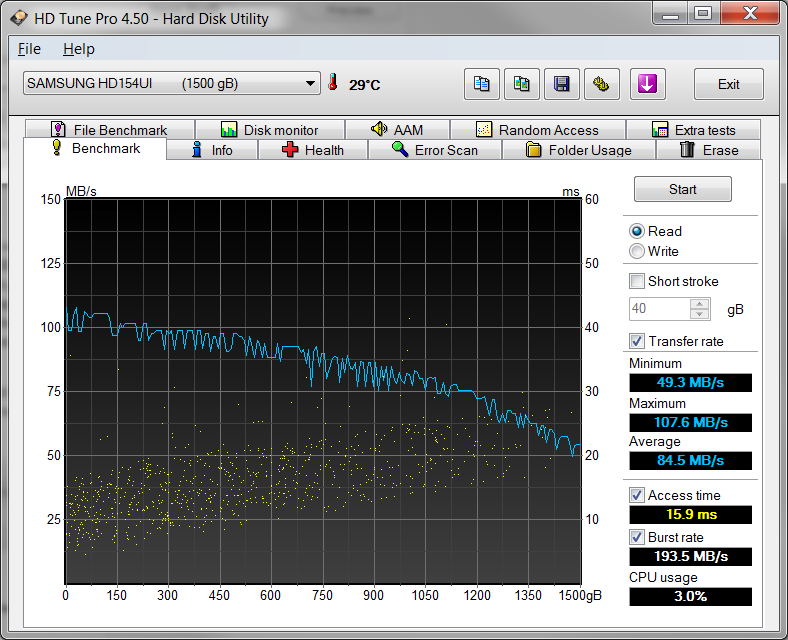This paragraph will be the ‘meat and gravy’ of this review simply because most want to know what this SSD will do for them. We can approach it from the angle that the SSD will last longer, not crash and lose all data at its end life, is lighter, cooler, uses less power which guarantees longer battery life, is more durable and visibly faster. We could also mention that if a laptop is dropped the chances of the SSD crashing and losing your data are extremely slim compared to the hard drive. The thing we would most like to demonstrate, however, is how the SSD continues to work under stress in comparison to the hard drive.
To do this, we would like to again draw your attention to the HD Tune Pro BenchMark of the Patriot earlier (left) and compare it to that of our relatively new Samsung SpinPoint F2 1.5TB hard drive (right).
.
The most obvious thing people notice when comparing the HDTune Pro Benchmark of the Torqx 2 to that of the Samsung is that there is a gradual decline in performance on the hard drive. Also important though is to recognize that the SSDs access time remains steady at 0.4ms while the hard drive tops out at 15.9ms, which is 39 times slower if you would believe it. The reasoning for this is pretty interesting.
An SSD consists of NAND Flash memory chips. When we seek out a piece of information, it is simply returned in one trip as oil would be moved through a pipeline. A hard drive is a bit different as information is stored on a magnetic platter which is spinning as fast as 10000rpm. When a request is made, the information must be located and then picked up and retrieved while the disk spins. As amazing as this truly is, its only logical that the information cannot be retrieved in one trip and the entire process must be started over again. With larger files, as would be seen in this testing, this puts alot of stress on the hard drive and it simply cannot maintain the performance we would like, thus the resulting performance drop from 100MB/s to just over 20MB/s. The same can be said of the access time as it would have been much quicker initially.
FINAL THOUGHTS
The straight and narrow on this SSD is that it isn’t an upper tier SSD and we wouldn’t try and bluff anyone into believing such. Having said that, it also doesnt carry the ‘upper tier’ price tag and coming in at $1.55/GB right now, its definitely one of the best SSD values available for those planning on the transition to solid state drives. Quite frankly, Patriot seems to have found the combination of value and capacity which has been a key factor keeping many away from solid state drives.
 With respect to performance, the key question then becomes what visual difference will the consumer see between their hard drive and the SSD.
With respect to performance, the key question then becomes what visual difference will the consumer see between their hard drive and the SSD.
The speed of the SSD is almost like the computer knew what you were going to do before hitting the enter key .This is the magic that comes from the almost instant access time of the SSD.
Last but not least, many will then ask what the difference will be between the Patriot Torqx 2 and an upper tier SSD such as that listed with the SandForce controller on board.
.
The truth is that it is impossible for anyone to differentiate between the two in typical computer use and differences will only become evident in things such as video editing and possibly large file transfers. This is the case statistically in less than .05% of computer use.
All in all, congratulations to Patriot for not only listening to consumer demand for a price conscious SSD that has availably capacity, but also, for sticking with the 99% of computer users that are still living in the SATA 2 computer world.
Pg1 – Introduction
Pg2 – Interior Components and Test Bench
Pg3 – Initial Testing
Pg4 – HDTune Testing
 The SSD Review The Worlds Dedicated SSD Education and Review Resource |
The SSD Review The Worlds Dedicated SSD Education and Review Resource | 

what about 128mb darm cache? that is important because not every ssd have that include it